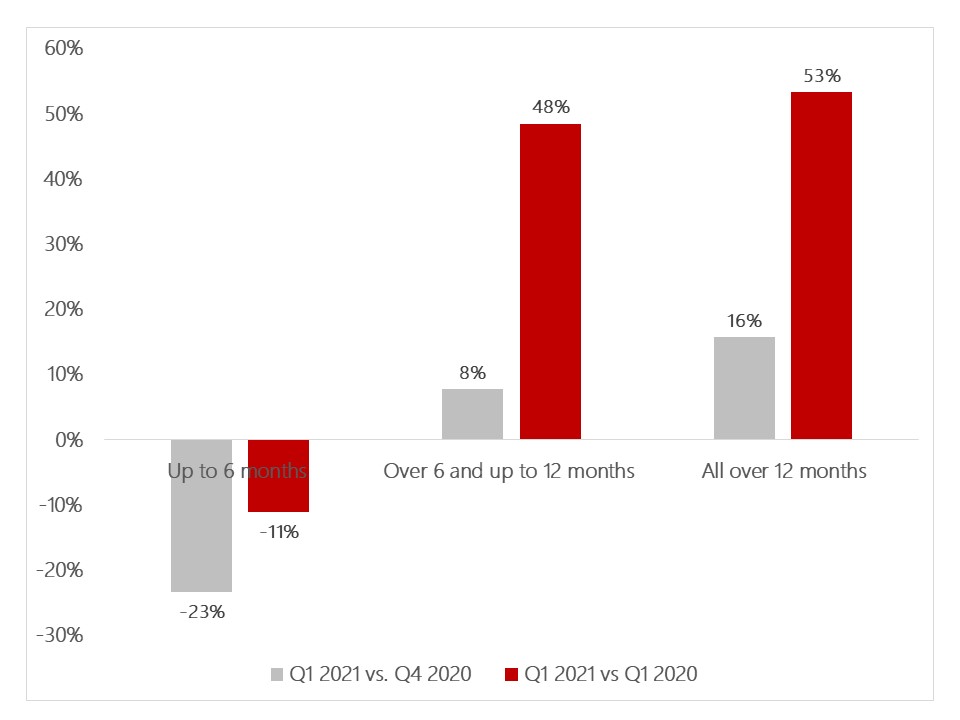Young workers continue to bear the brunt of the Covid-crisis
Posted on

Today’s labour market figures show that young people continue to be particularly affected by the Covid-19 crisis. Both employment and unemployment levels have fallen between January and March, suggesting younger people are choosing to stay in education longer and delaying joining the labour market. In addition to supporting those most at risk of long-term unemployment, there is a need to address structural issues with school-to-work transitions and improve labour market opportunities for young workers.
Broadly, today’s figures look positive. Employment levels have been largely stable leading into March 2021, with HMRC PAYE data showing a slight increase in the number of payroll employees in April, although this remains 772,000 below pre-pandemic levels. It is however very concerning that young workers (under 25) make up about 60% of the fall in employment.
This month’s data shows that while employment levels are improving among those over 25, younger people are falling out of the labour market. While the number of 18 to 24-year-olds who have been unemployed for less than 6 months has been falling, this doesn’t mean they are entering work. Long-term unemployment among young people saw a 16% increase on the quarter, and we noted a 2% increase in inactivity levels, adding another 31,000 young people this quarter who are out of work and not looking for work.
Figure 1: Percentage change in duration of unemployment for 18-24-year-olds, by quarter and by year

Source: Work Foundation calculations using ONS Dataset A01: Unemployment by age and duration (seasonally adjusted) 18 May 2021.
People may have different reasons for being inactive, some more positive than others. For example, an increasing number of people of all ages indicate they are not looking for work because they don’t feel that job opportunities are available to them, with this number increasing by 122% since spring 2020. This sense of discouragement will hopefully lessen with vacancy levels steadily increasing and new opportunities opening up now that restrictions are easing. We have also seen a steep rise in inactivity driven by take-up of full-time education. This rose by 5% on the quarter (117,000) and is up 15% from last year, representing an overall increase of 321,000 full time students from spring 2020.
The above are all signs that young workers are having a hard time accessing labour market opportunities. Government has already prioritised support for young people via the Kickstart Scheme, which provides fully-funded 6-month work placements for 16-24-year olds who are at risk of long-term unemployment.
The Scheme, which has been budgeted to support 300,000 placements, is currently due to run until December 2021. However, as advocated for by the Youth Futures Foundation, the Department for Work and Pensions should consider extending it, as youth unemployment is likely to remain stubbornly high throughout this year and next year. Uptake has been low due to operational challenges in getting the scheme up and running, with only 4,000 placements having commenced by March 2020, and many deferred due to lockdown restrictions. The end of the year deadline for Kickstart placements will therefore bring an end to this scheme before it can realise its full potential.
An extension to the Kickstart Scheme would also allow the impact of continuous improvement to be felt. Currently, Kickstart placements do not include a mandated training component, although employers are expected to provide some form of basic training on the job. This represents a missed opportunity, and will likely lead to uneven quality of placements depending on the employer. It is vital that the Department for Work and Pensions continually work to engage with employers to ensure placements provide value in the first place to the people undertaking them, and are not used as a cheaper alternative to a standard worker. These placements should be focused on building confidence; providing a bridge to learning more specific skills via an apprenticeship or further training. Government should consider introducing incentives for employers to keep Kickstart trainees on beyond their placement and providing additional support for those who do not find a permanent job, apprenticeship or training opportunity upon completion.
You can only access Kickstart if you are a recipient of Universal Credit, which leaves out a lot of young people who might benefit from support in obtaining placements. More flexibility around eligibility and allowing self-referrals could be another way to improve the scheme and ensure it reaches those who need it most. Although it is certain that support is required for young people who are farthest away from the labour market, there is also a need to address long-run structural issues with young people’s general access to labour market opportunities, for example by strengthening and diversifying school-to-work pathways. The recent FE white paper, which proposed involving employers more closely in the local provision of skills and training might be a good start provided these plans are matched with appropriate coordination and funding commitments by Government.
Disclaimer
The opinions expressed by our bloggers and those providing comments are personal, and may not necessarily reflect the opinions of Lancaster University. Responsibility for the accuracy of any of the information contained within blog posts belongs to the blogger.
Back to blog listing

